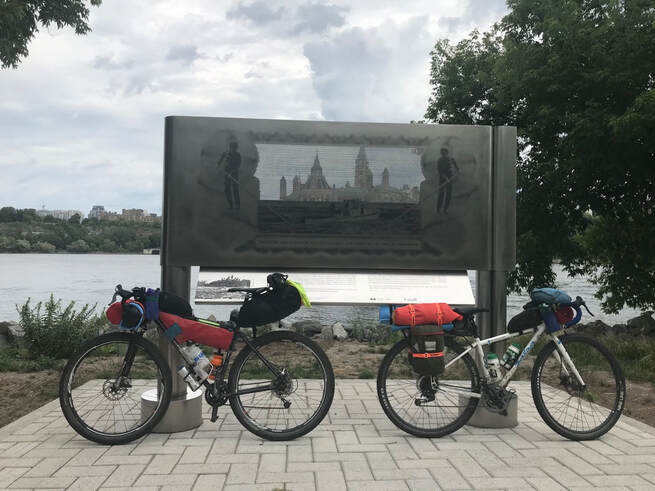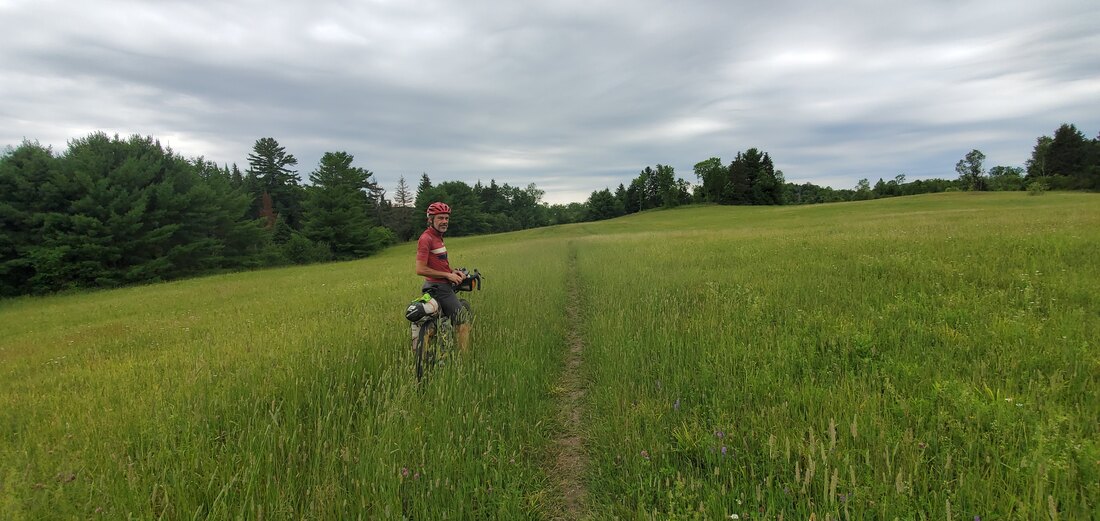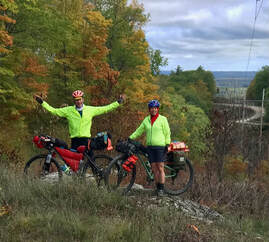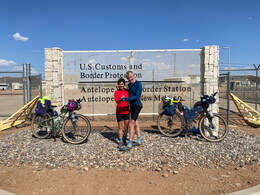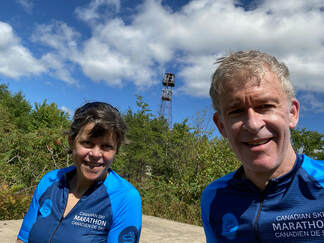the ldw story
Land Acknowledgement
We would like to acknowledge the Anishinaabe (Algonquin People) for their care and stewardship of this land. In an email to us Elder Albert Dumont from Kitigan Zibi Anishinabeg shared the following:
“All the areas you refer to in your email are on traditional Algonquin lands. You will be biking through places connected to the Ottawa River watershed. We are the 'People of the Great River'. You will see the greatness of our territory, its richness in resources and its wonderful waterways and spectacular trees. The Anishinabe, the People, had all they needed to live long, healthy and full lives in their territories before the arrival of Europeans occurred. I expect you will acknowledge this fact wherever and whenever you can as you move forward.”
We would like to acknowledge the Anishinaabe (Algonquin People) for their care and stewardship of this land. In an email to us Elder Albert Dumont from Kitigan Zibi Anishinabeg shared the following:
“All the areas you refer to in your email are on traditional Algonquin lands. You will be biking through places connected to the Ottawa River watershed. We are the 'People of the Great River'. You will see the greatness of our territory, its richness in resources and its wonderful waterways and spectacular trees. The Anishinabe, the People, had all they needed to live long, healthy and full lives in their territories before the arrival of Europeans occurred. I expect you will acknowledge this fact wherever and whenever you can as you move forward.”
The Story
With family and friends on both sides of the Ottawa River and up the Gatineau Valley it seemed natural to spend our long weekends visiting them by bike. For over 40 years we have been exploring the region by bike, canoe and on foot. Based on our bike travels with various set-ups (tandems, tandems with trailers, 'cross bikcs and bikepacking rigs) we have selected some of our favourite roads and trails and shared them in this route.
The Log Driver’s Waltz Bikepacking Route was conceived to showcase the picturesque landscape, historical sites, and varied culture of the Ottawa Valley and Outaouais regions. It follows the natural contours of old roads, trails and waterways that continue to play an important part of life in the region.
“This no doubt is a world-class route. Gravel and dirt road of dreams and just the right amount of mental toughness needed to get around the route.”
Matthew Kadey, 2022 Grand Depart, 4d 9h 30min
Prior to the arrival of European settlers most of the Ottawa River watershed was covered in vast stands of Eastern White Pine, a tree which is still omnipresent and is featured on our logo. As much as logging is still important economically in the Ottawa Valley, it’s reassuring to know that riders of the Log Driver’s Waltz will be able to celebrate many of these majestic giants in their living state.
As the pine was cut down for sale to Britain, settlers moved in behind the loggers to build roads and establish farms. As you ride along the historic roads you will see the remains of buildings, cedar fences and stone walls in places that you may find surprising. In the winter months, many of these settlers worked in the lumber camps stockpiling logs for the spring log drive. Following the spring ice break-up the logs were floated downstream on the Mississippi, Madawaska, Ottawa and Gatineau rivers towards Bytown (now known as Ottawa) where they were prepared for export. Along the way logs often got caught up in log jams in rocky rapids, at which point in a spectacle to behold it was the daring nature of the log drivers who “danced” out under perilous conditions onto these wood piles to free the logs and keep them floating downstream. The light feet and bravado of the log drivers was captured in the National Film Board short film Log Driver’s Waltz from which the route took its name. (The film was directed and animated by John Weldon and released in 1979.) Click on this link and watch the video if you want an earworm that can last you 800 kilometres! The song itself was written by Canadian folksinger and songwriter Wade Hemsworth who often likened the log driver’s motions to dancing. The NFB released a French version of the film, which was also interpreted by the McGarrigles. Canadian country music artist Stompin' Tom Connors made one Quebecois logger Big Joe Mufferaw (Jos Montferrand) the star of a 1970 chart-topping song. See if you can pick out the landmarks and geographical features he mentions in his song as you ride the Log Driver's Waltz Route.
In many parts of the region where agriculture has not proven viable there is now a robust and thriving maple syrup industry. Some of the modern operations collect the sap with tubing that you may see snaking through the woods as you pass by. Also visible are the sugar shacks where the sap is boiled down into the iconic sweetener. Logging for both softwoods and hardwoods continues to this day without the shanties and river drives. Instead, logs and harvesting equipment are now moved by truck. Thankfully, not all the towering white pine was felled by the ax and riders of the LDW will surely enjoy catching a glimpse of these friendly giants.
The arrival of the region’s railways allowed for the harvesting of hardwoods such as maple. Mines also flourished in the Pontiac region though they are now quiet. As the resource extraction declined and people tired of working unproductive land many moved away to larger centres. With declining population and the advent of road transport a number of the railways were abandoned and torn up. In some cases older roads have fallen into disrepair and been reclaimed by Mother Nature. As bikepackers, we can now take advantage of these historic routes, rail lines and trails to travel in relative quiet through beautiful terrain.
With family and friends on both sides of the Ottawa River and up the Gatineau Valley it seemed natural to spend our long weekends visiting them by bike. For over 40 years we have been exploring the region by bike, canoe and on foot. Based on our bike travels with various set-ups (tandems, tandems with trailers, 'cross bikcs and bikepacking rigs) we have selected some of our favourite roads and trails and shared them in this route.
The Log Driver’s Waltz Bikepacking Route was conceived to showcase the picturesque landscape, historical sites, and varied culture of the Ottawa Valley and Outaouais regions. It follows the natural contours of old roads, trails and waterways that continue to play an important part of life in the region.
“This no doubt is a world-class route. Gravel and dirt road of dreams and just the right amount of mental toughness needed to get around the route.”
Matthew Kadey, 2022 Grand Depart, 4d 9h 30min
Prior to the arrival of European settlers most of the Ottawa River watershed was covered in vast stands of Eastern White Pine, a tree which is still omnipresent and is featured on our logo. As much as logging is still important economically in the Ottawa Valley, it’s reassuring to know that riders of the Log Driver’s Waltz will be able to celebrate many of these majestic giants in their living state.
As the pine was cut down for sale to Britain, settlers moved in behind the loggers to build roads and establish farms. As you ride along the historic roads you will see the remains of buildings, cedar fences and stone walls in places that you may find surprising. In the winter months, many of these settlers worked in the lumber camps stockpiling logs for the spring log drive. Following the spring ice break-up the logs were floated downstream on the Mississippi, Madawaska, Ottawa and Gatineau rivers towards Bytown (now known as Ottawa) where they were prepared for export. Along the way logs often got caught up in log jams in rocky rapids, at which point in a spectacle to behold it was the daring nature of the log drivers who “danced” out under perilous conditions onto these wood piles to free the logs and keep them floating downstream. The light feet and bravado of the log drivers was captured in the National Film Board short film Log Driver’s Waltz from which the route took its name. (The film was directed and animated by John Weldon and released in 1979.) Click on this link and watch the video if you want an earworm that can last you 800 kilometres! The song itself was written by Canadian folksinger and songwriter Wade Hemsworth who often likened the log driver’s motions to dancing. The NFB released a French version of the film, which was also interpreted by the McGarrigles. Canadian country music artist Stompin' Tom Connors made one Quebecois logger Big Joe Mufferaw (Jos Montferrand) the star of a 1970 chart-topping song. See if you can pick out the landmarks and geographical features he mentions in his song as you ride the Log Driver's Waltz Route.
In many parts of the region where agriculture has not proven viable there is now a robust and thriving maple syrup industry. Some of the modern operations collect the sap with tubing that you may see snaking through the woods as you pass by. Also visible are the sugar shacks where the sap is boiled down into the iconic sweetener. Logging for both softwoods and hardwoods continues to this day without the shanties and river drives. Instead, logs and harvesting equipment are now moved by truck. Thankfully, not all the towering white pine was felled by the ax and riders of the LDW will surely enjoy catching a glimpse of these friendly giants.
The arrival of the region’s railways allowed for the harvesting of hardwoods such as maple. Mines also flourished in the Pontiac region though they are now quiet. As the resource extraction declined and people tired of working unproductive land many moved away to larger centres. With declining population and the advent of road transport a number of the railways were abandoned and torn up. In some cases older roads have fallen into disrepair and been reclaimed by Mother Nature. As bikepackers, we can now take advantage of these historic routes, rail lines and trails to travel in relative quiet through beautiful terrain.
Designing, Testing and Publishing the Log Driver's Waltz
It was good training for our successful Tour Divide 2022 ride!
See our Youtube Channel
It was good training for our successful Tour Divide 2022 ride!
See our Youtube Channel
|
|
|
Michel Collette: How he surprised us by being the first to ride Log Driver’s Waltz
Our goals in developing the LDW were twofold. We wanted the route to showcase the local scenery, roads, culture and history when done as a tour at a leisurely pace and also provide a challenge for riders wanting to push themselves.
In June 2020 Michel Collette, the first person to complete the LDW, approached the route in race mode. He came across an early version of the route that had been inadvertently set to “Public” on Ride With GPS. Given that we thought we had been keeping it private we were a bit shocked to see his Facebook post describing his experience. The feeling of surprise quickly gave way to one of happiness when we realized he had actually liked the route that we had developed!
After finishing he shared a few thoughts with us; it was great to get his perspective.
“The Log Driver’s Waltz (LDW) is a nice but tough course where you soon find out that the short asphalt sections are just there to get to more gravel!”
“It delivered on the bikepacking adventure feel, especially on the roads I had not done before.“
He went on to say he that he bikepacks for two very different reasons: “I like being outside and bike touring, and I like long bikepacking races. I was using the LDW as training for next year's Tour Divide so I did long days as opposed to admiring the scenery.” Unfortunately, as we now know, the 2021 Tour Divide was cancelled due to Covid 19 pandemic.
Michel went on to say, “People from outside this area looking for a challenge and/or an adventure on a well documented route should consider the LDW. Not only will the scenery be nice, the route will be fun.”
In 2021 he completed the LDW for a second time setting an FKT of 4 days.
Thanks, Michel, for testing the Beta Version of the Log Driver’s Waltz and then coming back to ride the finished version. We are so glad that you found it challenging and scenic enough to return.
We were very fortunate to draw on his experience as we prepared for the Tour Divide in 2022, a race/ride that Michel always wanted to do. Unfortunately it was not to be. By the time the 2022 edition came along he was ill with cancer. He continues to be a great role model for us in terms of his humanity, humour and zest for life. In 2023 we are dedicating the Grand Depart to Michel Collette, friend, father, husband, bikepacker.

Maple Apple Balls - Official Snack Of The LDW
Here is the official energy food snack of the Log Driver's Waltz. Take these along to fuel your bikepacking adventure and you'll end up feeling like it's time to do the sugar shack shuffle.
1 cup pitted dates
1 cup oat flakes
1 cup pecans
1 cup baked dried apples (the crunchy type not the soft type)
1/4 cup maple syrup, preferably dark grade
1 teaspoon vanilla extract
1 teaspoon cinnamon
1/8 teaspoon salt
Place dates in a bowl and soak in warm water for 20 minutes. Drain and pat away excess moisture with a paper towel.
In a food processor, blend together oats, pecans and dried apple into small pieces. Add drained dates, maple syrup, vanilla, cinnamon and salt; blend until mixture sticks together. Roll into 1-inch balls. You should get about 14 balls.
Here is the official energy food snack of the Log Driver's Waltz. Take these along to fuel your bikepacking adventure and you'll end up feeling like it's time to do the sugar shack shuffle.
1 cup pitted dates
1 cup oat flakes
1 cup pecans
1 cup baked dried apples (the crunchy type not the soft type)
1/4 cup maple syrup, preferably dark grade
1 teaspoon vanilla extract
1 teaspoon cinnamon
1/8 teaspoon salt
Place dates in a bowl and soak in warm water for 20 minutes. Drain and pat away excess moisture with a paper towel.
In a food processor, blend together oats, pecans and dried apple into small pieces. Add drained dates, maple syrup, vanilla, cinnamon and salt; blend until mixture sticks together. Roll into 1-inch balls. You should get about 14 balls.
Route Developers
In 2022 Jen and Eric bikepacked almost 8800 km including the Grand Departs on the Tour Divide (33 d) and the Log Driver’s Waltz (3.5 d), and a “pairs” time trial on the North of Seven 770 (5 d). In 2019 they were amongst the first few riders to complete the BT 700 in Southern Ontario which they did on a whim in lieu of their annual wilderness canoe trip. That trip was their first time following a curated bikepacking route and the experience of being taken to bits of road, trail and track that generally only locals know about piqued their interest in the sport.
On the drive home to Ottawa they realized that Lanark Highlands of Ontario and the Outaouais Region of Quebec, areas they know well from cycling, canoeing, skiing and family ties, was a bikepacking destination waiting to be discovered. They set about creating the Log Driver’s Waltz with the goals of showcasing the region, contributing to the growing bikepacking community in Ontario, injecting a few tourist dollars, creating connections between locals and riders all the while providing a challenging and scenic route that Ontario, Quebec and New England riders could access without extensive airline travel. In the process they learned how to plan using Ride with GPS, ground truthed many segments of the route over successive weekends and discovered that the Lanark Highlands and Gatineau Valley had even more to offer than they had realized. As the Log Driver’s Waltz gained popularity, beginning and intermediate bikepackers began to ask for some more introductory routes. In response they have mapped out and curated almost a dozen routes of 2-5 days duration which along with the Log Driver’s Waltz can be found on their website.
Jen and Eric believe that there are hidden gems to be discovered in all localities and it is by sharing well curated routes that bikepacking route developers can share this knowledge with riders from near and far. They continue to collaborate with other route developers in Ontario, across Canada, the US and Europe to discuss common challenges and successes and contribute to the greater bikepacking community. They hope that others will agree that bikepacking routes should be free and freely shared. Their goal is to get people out exploring.
They can be reached via the website or through social media (@thelogdriverswaltz).
Acknowledgements
We would like to acknowledge the mentorship and guidance of Matt Kadey as we developed the route. Matt is a prolific route planner in southern and central Ontario. You can find his routes at http://www.bt700.ca/ . Matt generously shared his technical expertise as we went through the process of mapping the route and creating the website.
Thanks to Adrian Grant of www.ridegravel.ca for his route suggestions and identification of crown land camping spots along the LDW.
David Wright had some great intel that led us to the old train tunnel under HWY 17.
All our friends and acquaintances who have made suggestions and requests since we released the Log Driver's Waltz for the inspiration to create a suite of routes to meet the needs of riders of different levels and aspirations. You folks make it all worthwhile.
Thanks Michel Baker for translating some of the Gatineau Reels route descriptions.
We would like to acknowledge the mentorship and guidance of Matt Kadey as we developed the route. Matt is a prolific route planner in southern and central Ontario. You can find his routes at http://www.bt700.ca/ . Matt generously shared his technical expertise as we went through the process of mapping the route and creating the website.
Thanks to Adrian Grant of www.ridegravel.ca for his route suggestions and identification of crown land camping spots along the LDW.
David Wright had some great intel that led us to the old train tunnel under HWY 17.
All our friends and acquaintances who have made suggestions and requests since we released the Log Driver's Waltz for the inspiration to create a suite of routes to meet the needs of riders of different levels and aspirations. You folks make it all worthwhile.
Thanks Michel Baker for translating some of the Gatineau Reels route descriptions.
If you enjoyed the Log Driver's Waltz or our other routes, please consider helping us cover the costs of developing and maintaining the route files and website. Thanks!
|
|
Please tell your friends all about your experience on the Log Driver's Waltz and encourage them to try it! Thanks!

